Related Research Articles

The 36th Infantry Division ("Arrowhead"), also known as the "Panther Division", "Lone Star Division", "The Texas Army", or the "T-patchers", is an infantry division of the United States Army and part of the Texas Army National Guard. It was organized during World War I from units of the Texas and Oklahoma National Guard. As an all-Texas unit, it was called for service for World War II 25 November 1940, was sent to the European Theater of Operations in April 1943, and returned to the Texas Army National Guard in December 1945.
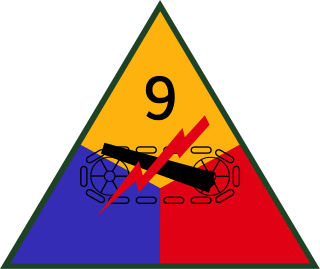
The 9th Armored Division was an armored division of the United States Army during World War II. In honor of their World War II service, the 9th was officially nicknamed the "Phantom Division."
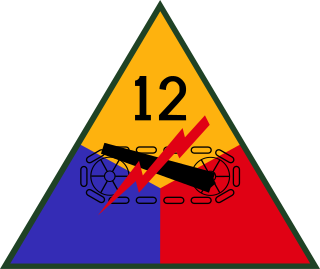
The 12th Armored Division was an armored division of the United States Army in World War II. It fought in the European Theater of Operations in France, Germany and Austria, between November 1944 and May 1945.

The 20th Armored Division was an armored division of the United States Army that fought in World War II. It was activated on 15 March 1943 at Camp Campbell in Kentucky.
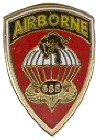
The 555th Parachute Infantry Battalion, nicknamed The Triple Nickles, was an all-black airborne unit of the United States Army during World War II.
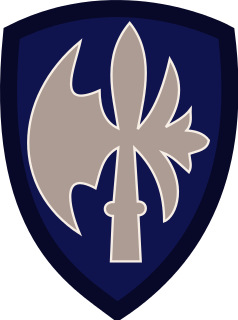
The 65th Infantry Division—nicknamed the "Battle-Axe Division"—was an infantry division of the United States Army that served in World War II. Its shoulder patch is a white halberd on a blue shield.

The 8th Infantry Division, ("Pathfinder") was an infantry division of the United States Army during the 20th century. The division served in World War I, World War II, and Operation Desert Storm. Initially activated in January 1918, the unit did not see combat during World War I and returned to the United States. Activated again on 1 July 1940 as part of the build-up of military forces prior to the United States' entry into World War II, the division saw extensive action in the European Theatre of Operations. Following World War II, the division was moved to West Germany, where it remained stationed at the Rose Barracks in Bad Kreuznach until it was inactivated on 17 January 1992.

The 103rd Infantry Division was a unit of the United States Army that served in the U.S. Seventh Army of the 6th Army Group during World War II.

The 92nd Infantry Division was an African-American infantry division of the United States Army that served in both World War I and World War II. The military was then segregated. The division was organized in October 1917, after the U.S. entry into World War I, at Camp Funston, Kansas, with African-American soldiers from all states. In 1918, before leaving for France, the American buffalo was selected as the divisional insignia due to the "Buffalo Soldiers" nickname, given to African-American cavalrymen in the 19th century. The divisional nickname, "Buffalo Soldiers Division", was inherited from the 366th Infantry, one of the first units organized in the division.

The 63rd Infantry Division was an infantry division of the United States Army that fought in Europe during World War II. After the war it was inactivated, but later the division number and shoulder sleeve insignia were authorized for use by the 63rd Army Reserve Command (ARCOM).
The 366th Infantry Regiment was an all African American (segregated) unit of the United States Army that served in both World War I and World War II. In the latter war, the unit was exceptional for having all black officers as well as troops. The U.S. military did not desegregate until after World War II. During the war, for most of the segregated units, all field grade and most of the company grade officers were white.

The 3-inch gun M5 was an anti-tank gun developed in the United States during World War II. The gun combined a 3-inch (76.2 mm) barrel of the anti-aircraft gun T9 and elements of the 105 mm howitzer M2. The M5 was issued exclusively to the US Army tank destroyer battalions starting in 1943. It saw combat in the Italian Campaign and on the Western Front in Northwest Europe.

The Army Ground Forces were one of the three autonomous components of the Army of the United States during World War II, the others being the Army Air Forces and Army Service Forces. Throughout their existence, Army Ground Forces were the largest training organization ever established in the United States. Its strength of 780,000 troops on 1 May 1942 grew to a peak of 2,200,000 by 1 July 1943. Thereafter its strength declined as units departed for overseas theaters.
The tank destroyer battalion was a type of military unit used by the United States Army during World War II. The unit was organized in one of two different forms—a towed battalion equipped with anti-tank guns, or a mechanized battalion equipped with armored self-propelled guns. The tank destroyer units were formed in response to the German use of massed formations of armored vehicles units early in WWII. The tank destroyer concept envisioned the battalions acting as independent units that would respond at high speed to large enemy tank attacks. In this role, they would be attached in groups or brigades to corps or armies. In practice, they were usually individually attached to infantry divisions. Over one hundred battalions were formed, of which more than half saw combat service. The force was disbanded shortly after the end of the war when the concept had been shown to be militarily unsound.
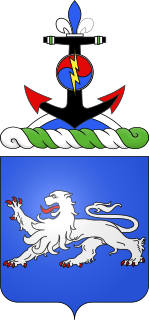
The 68th Armor Regiment is an armored regiment of the United States Army. It was first activated in 1933 in the Regular Army as the 68th Infantry Regiment.
The 614th Tank Destroyer Battalion was a tank destroyer battalion of the United States Army active during the Second World War. The unit was activated in 1942 and trained through the late summer of 1944. Arriving on the Normandy coast in October, they moved to the Metz, France, area, seeing their first action in late November. In early December, they were attached to the 103rd Infantry Division, a pairing that was to last through the end of combat in Europe. The 3rd Platoon, Company C, of the 614th was the first African-American unit to receive a Distinguished Unit Citation during World War II. They received credit for the Northern France, Rhineland, Ardennes-Alsace and Central Europe campaigns.
The 612th Tank Destroyer Battalion was a unit of the United States Army during World War II. It played an instrumental role in defending Hofen during the Battle of the Bulge. The specialized tank destroyer unit was attached to various organizations during the war. In December, 1944, the twelve 3-inch guns of Company A were integrated into the defensive positions of the 395th Infantry Regiment and were key to keeping the attacking Sixth Panzer Army from gaining essential objectives in the first days of the offensive.
Operation Grapeshot order of battle is a listing of the significant formations that were involved in the Spring 1945 offensive in the Apennine Mountains and the Po valley in northern Italy, April 1945 – May 1945.
The 827th Tank Destroyer Battalion was a tank destroyer battalion of the United States Army active during the Second World War. It was activated in April 1942 as a segregated African American unit, deploying to Europe at the end of 1944 and attached to 12th Armored Division. It saw action during Operation Nordwind in January 1945, where elements of the battalion performed creditably. However, its overall combat record was marred by severe disciplinary problems and insufficient training. It was withdrawn in February, and assigned to rear-area duties; while it nominally remained active for the remainder of the war, it had been effectively disbanded.

Separate tank battalions were military formations used by the United States Army during World War II, especially in the European Theater of Operations. These battalions were temporarily attached to infantry, armored, or airborne divisions according to need, though at least one battalion spent the entire war in Europe attached to one division. They were also known as general headquarters ("GHQ") tank battalions.
References
- Lee, Ulysses (1966). The employment of Negro troops. Washington D.C.: US Army Center for Military History. Archived from the original on 27 July 2021. Retrieved 27 December 2007.